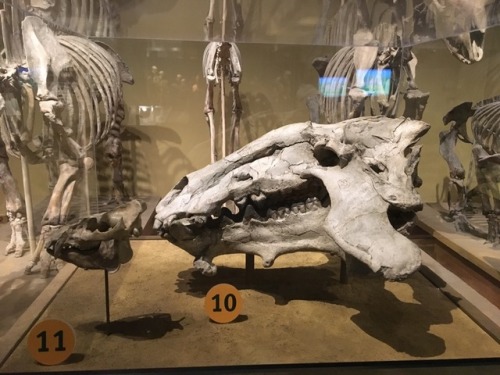Iphleandro-blog - Real

More Posts from Iphleandro-blog and Others
Fiann on Instagram: “Here is a shot along the vertebral column of my smallest ichthyosaur called Bella. At the end you’ll see how her vertebrae compare to the biggest vert I’ve found from the same location. This huge bone is from an animal that would have been over 8 metres long, which is a bit bigger than poor little Bella! These fossils are both around 198 million years old. Bella was prepared by the ever talented @alexander_james_moore.
WHAT A JERK

Entelodonts: terrifying.
Shown here compared to a modern pig skull on the left. (Entelodonts were actually more closely related to whales and hippos than pigs.)
” The title which I most covet is that of teacher. The writing of a research paper and the teaching of freshman calculus, and everything in between, falls under this rubric. Happy is the person who comes to understand something and then gets to explain it. “ - Marshall Cohen.

A happy calssroom - illustrated by Lowell Hess - From: The Giant Golden Book of Mathematics Library Binding – June, 1968 by Irving Adler.

Ammonites on Matrix (Quenstedtoceras sp., Jurassic) - Volga River, Ulyanovsk, Russia
This extremely artistic assemblage of large and small ammonites from Russia demonstrate an intense iridescence and highlights due to the presence of metallic Pyrite. The cluster has been positioned on a new matrix, as the grainy rock in which these Quenstedtoceras cephalopods were collected is not hard nor stable enough to display them permanently. The added component is an attractive piece of what is known as septarian, a mud-like material that grows in nodules. In this instance, yellowish Calcite crystals and gray sediment have formed the rock on which these colorful ammonites reside. The cluster is quite representative of the Volga River material, and that combination results in a dramatic display specimen.
Overall Measurements: 6.30 x 5.51 x 5.71 inches (16.00 x 14.00 x 14.50 cm)

Morphing necker cubes

I FOUND IT GUYS I SPENT HALF AN HOUR LOOKING FOR THIS VIDEO AND ITS HERE
This is how far into the earth humans have dug so far.
Study tips
Be active while studying :
Do not mindelssly skip through your notes.Make sure you are fully understanding the material that you are working on. Ask yourself questions. If you can answer them , that’s cool, if you can’t, note them down on a post-it and ask your teacher or classmates or maybe google it. If you can’t focus take a break and come back later.
Set the mood for studying:
Wash you face and hands with cold water, or take a shower. Put on comfy clothes. Organize your study space and clean it up. Get yourself a snack and a cup of coffee or tea or just plain water, whatever works for you. Set the stuff you need for studying and get rid of anything else. If you don’t need your phone for studying, turn the wi-fi off and put it away from you. Start a study playlist if you want. Put your to do list right in front you and get to it.
Make a TO DO list:
Grab a white sheet of paper. Brain dump all the tasks you have to do for the day, prioritize them, and write them again in a clean way, while dismissing the unimportant tasks if you don’t have enough time.
Take breaks when you need them :
If you take too much you’ll lose focus, if you don’t take enough, your studying won’t be effective. If you can’t get yourself to study, set a timer for 30 min, take a 10 min break and work to add to the length of the studying each time.
Eat the frog :
Start with the boring and hardest tasks first. You’ll be more motivated to get work done after you get them out of the way.
Break up big goals to shorter clear tasks :
Don’t write for example ’ study maths ’ as a task, instead note exactly how you’re planning to do it, for instance ’ work 10 exercices from a certain book’ . It feels easier to get work done when it’s not just a vague goal.
Start homework as soon as you get. If you are busy, schedule a time block for doing it asap.
Break big projects to smaller tasks and schedule them on your planner.
You’ll more likely do them if you see them in your planner, then if it’s just an unclear deadline freaking you out and that you don’t know how to start.
Go to your classes and pay attention to your teachers:
Be ACTIVE. Ask questions, participate in class, it’s really helpful . Take your own notes, in your own way and don’t do just mindlessly note everything your teacher says. Pick just the important stuff or those that aren’t in the text book. Draw mind maps, lists, diagrams, use colors and leave space and margins.
When reviewing your notes, make them easier to understand by adding remarks from other sources in the margings.
I don’t know if it’s clear enough. But while reviewing my notes I like to use a pencil and try to make my notes easier to grasp, for example, write down a general way to solve all the problems that are similar to one that you have seen in class.
Study EVERYDAY:
Make studying a daily task. Don’t wait until the night before the test. Stay up to date with your classes.
Prepare your classes ahead of time time:
Read the text book. Google it. Watch YouTube videos. Take some notes and write questions for all the things you didn’t understand to ask in class. This way you won’t be overwhelmed in class and manage to not fall behind and make the most out if it.
Practice practice practice problems :
Work as much exercices as you can, and all the previous exams that you get your hands on. That way you know what the professor usually test the students on, and also you get used to working with your lessons, especially for maths and physics and such subjects.
-
 bettylovee liked this · 3 years ago
bettylovee liked this · 3 years ago -
 spanishfly86 reblogged this · 4 years ago
spanishfly86 reblogged this · 4 years ago -
 spanishfly86 liked this · 4 years ago
spanishfly86 liked this · 4 years ago -
 tbh0z reblogged this · 4 years ago
tbh0z reblogged this · 4 years ago -
 cesprit liked this · 4 years ago
cesprit liked this · 4 years ago -
 s7antob reblogged this · 4 years ago
s7antob reblogged this · 4 years ago -
 s7antob liked this · 4 years ago
s7antob liked this · 4 years ago -
 blondethots liked this · 4 years ago
blondethots liked this · 4 years ago -
 porcelainrosetta liked this · 4 years ago
porcelainrosetta liked this · 4 years ago -
 6-impossiblethings liked this · 4 years ago
6-impossiblethings liked this · 4 years ago -
 soul-prints liked this · 4 years ago
soul-prints liked this · 4 years ago -
 ambientsounddesigns liked this · 4 years ago
ambientsounddesigns liked this · 4 years ago -
 lintangindahchsh liked this · 4 years ago
lintangindahchsh liked this · 4 years ago -
 talkaboutyourjoy reblogged this · 4 years ago
talkaboutyourjoy reblogged this · 4 years ago -
 rienextdoor liked this · 4 years ago
rienextdoor liked this · 4 years ago -
 awakenedbyhate liked this · 4 years ago
awakenedbyhate liked this · 4 years ago -
 janeaustenisreading reblogged this · 4 years ago
janeaustenisreading reblogged this · 4 years ago -
 neeksphere liked this · 4 years ago
neeksphere liked this · 4 years ago -
 mesa-mou-vrexei liked this · 4 years ago
mesa-mou-vrexei liked this · 4 years ago -
 riseabovetheexpectations liked this · 4 years ago
riseabovetheexpectations liked this · 4 years ago -
 vintagelove41 liked this · 4 years ago
vintagelove41 liked this · 4 years ago -
 percyxloki-shipper liked this · 5 years ago
percyxloki-shipper liked this · 5 years ago -
 primaldoubtsandall liked this · 5 years ago
primaldoubtsandall liked this · 5 years ago -
 make500inaday reblogged this · 5 years ago
make500inaday reblogged this · 5 years ago -
 mistajaysbay liked this · 5 years ago
mistajaysbay liked this · 5 years ago -
 cleverwinnerroadshark liked this · 5 years ago
cleverwinnerroadshark liked this · 5 years ago -
 alessia-rosi01 liked this · 5 years ago
alessia-rosi01 liked this · 5 years ago -
 ioha liked this · 5 years ago
ioha liked this · 5 years ago -
 idontcarewhatmyusernameis9 liked this · 5 years ago
idontcarewhatmyusernameis9 liked this · 5 years ago -
 observing53 liked this · 5 years ago
observing53 liked this · 5 years ago -
 jws-corner liked this · 5 years ago
jws-corner liked this · 5 years ago -
 resipunk liked this · 5 years ago
resipunk liked this · 5 years ago -
 trillobite liked this · 5 years ago
trillobite liked this · 5 years ago -
 claudiatraveldesire liked this · 5 years ago
claudiatraveldesire liked this · 5 years ago -
 tevinfromlosangeles reblogged this · 5 years ago
tevinfromlosangeles reblogged this · 5 years ago -
 kalonika reblogged this · 5 years ago
kalonika reblogged this · 5 years ago -
 s-hurricane liked this · 5 years ago
s-hurricane liked this · 5 years ago -
 10ofpentacles liked this · 5 years ago
10ofpentacles liked this · 5 years ago -
 awh-rats liked this · 5 years ago
awh-rats liked this · 5 years ago